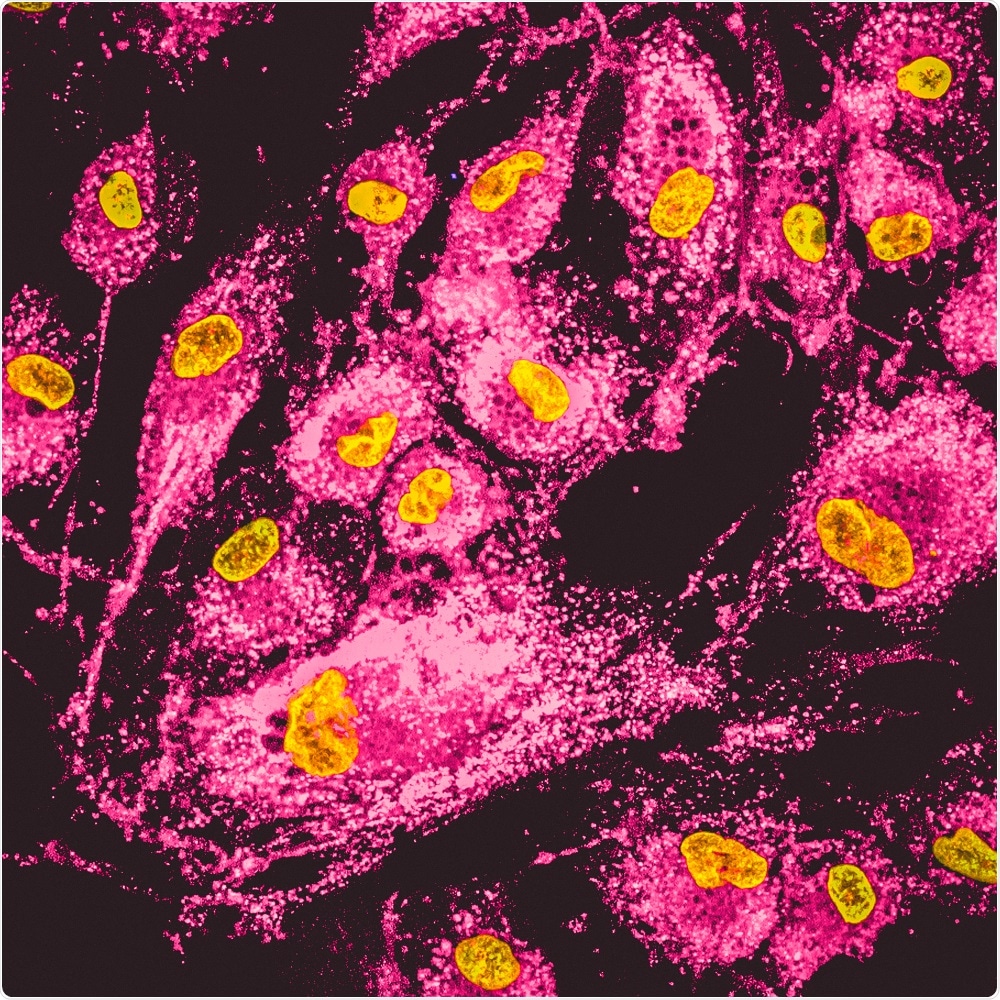Researchers in the US have developed a platform for the 3D super-resolution imaging at the nanoscale level that has revealed unexpected findings in mammalian cells.

Image Credit: Vshivkova/Shutterstock.com
The new technique enables the nanoscale relationship of proteins in the context of the overall cellular structure to be directly visualized, which led to surprising discoveries about every cellular system the team looked at.
The spatial organization of the thousands of proteins in cells serves a wide range of biochemical functions.
So, far researchers’ understanding of how cells are organized and their proteins compartmentalized has largely come from studies in biochemistry, molecular biology, and electron microscopy, meaning much of the information has been speculative.
Electron microscopy (EM) has provided insights into the intricate eukaryotic environment, with spatial organization incorporating scales ranging from nanometer-sized molecules to structures such as actin fibers and microtubules that span the entire cell.
The challenge
However, even within compartments of the same cell, significant structural differences exist in the individual components including the organization of nuclear chromatin and of the endoplasmic reticulum, which is complex, intricate and compact in the perinuclear region, but sparsely reticulated in actin projections at the edge of the cell.
Thus, a comprehensive picture of cellular organization requires nanometer-level three-dimensional (3D) imaging of whole cells,”
Correlative super-resolution (SR) fluorescence and EM can elucidate details of the nanoscale relationship of specific proteins but this correlative imaging has been compromised by limitations in terms of resolution, sensitivity, and field of view, as well as in terms of preserving ultrastructure and retaining fluorescence.
What have the US researchers done?
Now, David Hoffman (Howard Hughes Medical Institute, Ashburn, Virginia) and colleagues have developed a pipeline that can preserve fluorescence in vitreously frozen whole mammalian cells and provide imaging by multicolor three-dimensional structured illumination (3D SIM) and single-molecule localization microscopy (SMLM).
The same cells can be imaged by focused ion beam scanning EM (FIB-SEM) at nanoscale resolution and images registered at nanoscale precision.
“The pipeline ensures accurate ultrastructure preservation, permits independent optimization of SR and EM imaging modalities, and provides a comprehensive view of how specific subcellular components vary across the cellular volume,” writes the team.
The researchers say that even at its lower level of resolution, the cryo-structural illumination (cryo-SIM) enabled distinct discrimination of vesicles with similar morphologies and helped to segment 3D structures at FIB-SEM resolution within the intracellular environment.
Unexpected protein and ultrastructure relationships
As reported in the journal Science, the researchers found unexpected relationships between protein and global cell ultrastructure for nearly every system they probed.
They were surprised to find intranuclear vesicles that contained proteins associated with the endoplasmic reticulum; peroxisomes of increasing size and irregular morphology and endolysosomal regions that were extremely diverse and had a complex morphology.
They also found web-like adhesions between cerebellar granule neurons and discovered heterochromatin and euchromatin domains that were sub-characterized based on the presence or absence of transcriptional activity.
More generally, whole-cell cryo-SR/ FIB-SEM can reveal compartmentalized proteins within known subcellular components, aid in the discovery of new subcellular components, and classify unknown EM morphologies and their roles in cell biology,”
Hoffman and team.
“Our findings illustrate the value of a comprehensive multimodal view of ultrastructural variability across whole cells.”
Room for improvement
The researchers say they can think of a number of areas where the platform could be improved. Firstly, they suggest the imaging of live cells be performed prior to freezing, which would enable cellular dynamics to be correlated with ultrastructure, refine the selection of cells with physiological behavior and allow pharmacological or optogenetic changes to be introduced.
However, plans for how whole live-cell imaging could be quickly and non-invasively changed to frozen state imaging would require significant technological advances.
Secondly, expanding the application of cryo-SR/FIB-SEM analysis to more physiologically relevant models such as small gene-edited organisms and organoids should be feasible, says the team.
Thirdly, for both cryo-SIM and cryo-SMLM analysis, the axial resolution could be enhanced by about five- to ten-fold by adding a dual-window cryostat that has opposed objectives and coherent detection.
“A next-generation pipeline combining these improvements could prove an even more powerful discovery platform to link 3D subcellular dynamic processes in cells, small whole organisms, and acute tissue sections to the nanoscale spatial distribution of the proteins driving these processes, all in the context of the global intracellular ultrastructure,” writes the team.
“However, even in its current form, our cryo-SR/FIB-SEM system can address a broad range of biological questions and is available to outside users wanting to do so.”
The researchers say their new pipeline provides a powerful hypothesis generator for improving understanding of biochemical findings in the spatially compartmentalized cell.
“Our approach also carefully preserves the native ultrastructure upon which such hypotheses are based, thus enabling cell-wide or cell-to-cell investigation of the natural variability in protein ultrastructure relationships,” concludes the team.
Journal reference:
Hoffman D, et al. Correlative three-dimensional super-resolution and block-face electron microscopy of whole vitreously frozen cells. Science 2020;367 (6475) DOI: 10.1126/science.aaz5357